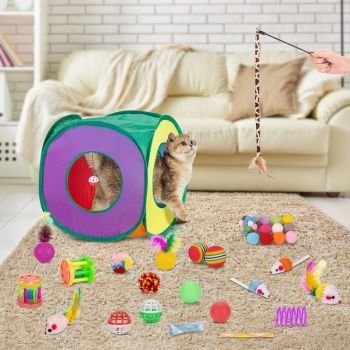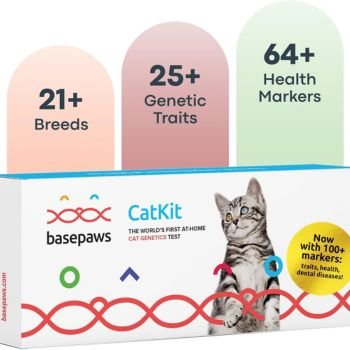Welcome to the world of feline wonders, where the wild meets the domestic – the Bengal cat. These mesmerizing creatures are not just pets; they are a living embodiment of grace, beauty, and intelligence. In this exploration, we delve into the origin, characteristics, and the myriad reasons why Bengal cats are the epitome of an extraordinary feline companion.
Origin and History: A Journey from the Wild to Your Home
The Bengal cat’s lineage can be traced back to the Asian leopard cat (ALC), a small wildcat native to Southeast Asia. The breed as we know it today began in the 1960s when breeders selectively crossed ALCs with domestic cats, creating the stunning spotted and marbled patterns that define the Bengal breed.
Characteristics: The Allure of the Wild
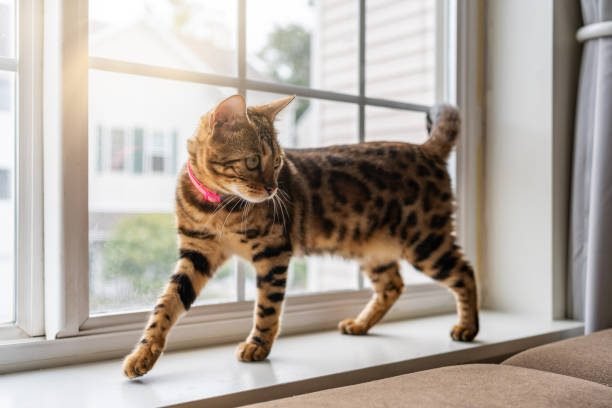
Shape and Size: Elegance in Motion
Bengal cats are known for their sleek, muscular bodies and lithe, athletic build. The ideal Bengal is medium to large in size, with males weighing between 10-15 pounds and females slightly smaller, ranging from 8-12 pounds. Their bodies are well-proportioned, reflecting strength and agility.
Color: A Palette of the Exotic
Bengals boast a distinctive coat that sets them apart. The most recognized patterns are spotted and marbled, each contributing to the breed’s wild appearance. The spots can vary in size and shape, creating a unique mosaic on their coat. Bengal cats come in various color variations, including brown, silver, charcoal, and snow, each with its own mesmerizing charm.
Coat: The Silken Touch
Bengal cats have a short, dense coat that lies close to their body, offering a soft and luxurious feel. The coat’s texture is often compared to that of a pelt, adding to the feline’s wild allure. The short fur requires minimal grooming compared to longer-haired breeds.
Eyes: Windows to the Soul
One of the most captivating features of Bengal cats is their eyes. Large and expressive, their eyes are typically almond-shaped and can be green, gold, or hazel. The vivid coloration adds an element of mystique to their overall appearance.
Tail: A Mark of Elegance
The Bengal cat’s tail is an extension of its elegance, tapering to a point and adorned with a series of rings or spots. The tail’s pattern complements the markings on the body, creating a harmonious visual appeal.
Head: The Portrait of Grace
The head of a Bengal cat is small to medium in size, with a slightly rounded skull and well-defined cheekbones. The nose is broad, and the profile forms a gentle curve, contributing to their distinctive facial expression.
Ears: Alert and Athletic
Bengal cats have medium to small ears that are rounded at the tips. The alert positioning of their ears reflects their athletic nature, always ready for action and exploration.
Paws: The Foundation of Agility
The paws of Bengal cats are compact and round, with the hind legs slightly longer than the front legs, providing a powerful spring for their agile movements. The toes are close-knit, and the paw pads may have distinctive spots, adding a touch of uniqueness.
Voice: Communicative and Soft
Bengal cats are not known for being excessively vocal, but they can communicate with a soft and gentle voice. They may chirp, trill, or purr, especially when expressing contentment or seeking attention.
Behavior: A Symphony of Energy and Affection
Intelligent and Curious:
Bengal cats are renowned for their intelligence and curiosity. They enjoy problem-solving activities, such as puzzle toys and interactive games. Providing mental stimulation is key to keeping them engaged and happy.
Energetic and Agile:
Expect a Bengal cat to be on the move. Their high energy levels and agility make them skilled climbers and jumpers. Providing vertical spaces, such as cat trees and shelves, allows them to satisfy their natural instincts.
Communicative and Expressive:
While not excessively vocal, Bengal cats use a variety of sounds to communicate. From soft chirps to trills, they express themselves in a unique feline language. Understanding their vocalizations enhances the human-feline bond.
Interests and Lifestyle: A Bengal’s World
Interactive Playtime:
Bengal cats thrive on interactive play. Engage them with feather wands, laser pointers, or puzzle toys to stimulate their minds and provide physical exercise. Regular play sessions strengthen the bond between you and your Bengal companion.
Vertical Exploration:
Create a vertical wonderland for your Bengal cat. Install cat trees, shelves, and perches to satisfy their instinct to climb and observe their surroundings from elevated positions. This not only meets their needs but also adds a touch of elegance to your home.
Window Watching:
Bengals love observing the outside world. Place a cat tree or perch near a window to allow them to indulge in bird-watching or simply enjoy the changing scenery. This satisfies their natural curiosity and provides mental stimulation.
Secure Outdoor Spaces:
If you have a safe and secure outdoor space, consider allowing your Bengal cat supervised outdoor access. Constructing a catio (enclosed patio for cats) provides a protected environment where they can experience the outdoors safely.
Lifestyle Considerations: Making Your Home Bengal-Friendly
Enriching Environments:
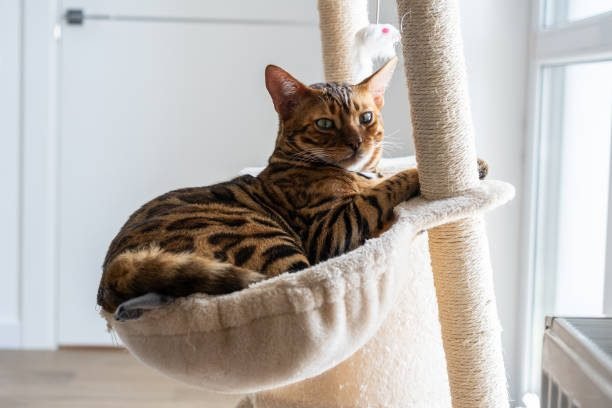
Create an enriching environment by offering a variety of toys, scratching posts, and cozy spots for your Bengal cat. Rotation of toys and introduction of new items keep them mentally stimulated.
Read more: 8 BEST CAT EXERCISE WHEEL TO KEEP YOUR FELINE FIT AND ACTIVE
Consistent Routine:
Bengal cats appreciate a consistent routine. Regular feeding times, play sessions, and designated quiet times help them feel secure and build a sense of predictability in their daily lives.
Positive Reinforcement:
Utilize positive reinforcement techniques when training or interacting with your Bengal cat. Reward good behavior with treats or affection to reinforce positive associations. This encourages them to repeat desirable actions.
Respect for Independence:
While affectionate, Bengal cats also value their independence. Respect their need for personal space and provide hideaway spots or cozy beds where they can retreat when they desire solitude.
Nutrition: Fueling the Feline Dynamo
Tailoring Diet to Bengal Cats
To support their active lifestyle, Bengal cats require a nutrient-rich diet. High-quality cat food, tailored to their specific needs, ensures they receive the essential nutrients for optimal health and vitality.
Dietary Preferences and Tips
Experiment with different textures and flavors to find the perfect balance for your Bengal cat. Regular veterinary check-ups help tailor their diet to their individual requirements.
Favorite Foods: Catering to Bengal Tastes
Bengal cats often have individual food preferences. Some enjoy the crunch of dry kibble, while others prefer the moisture of wet food. Offering a mix of both can satisfy their varied tastes.
Specific Nutritional Regimen
Consider a diet rich in animal proteins to mimic their natural prey. Look for cat food formulas that list meat as the primary ingredient and are free from unnecessary fillers. Consult with your veterinarian to create a specific nutritional regimen tailored to your Bengal cat’s needs.
Health Care: Nurturing the Wild Heart
Common Health Issues
While generally healthy, Bengal cats may be prone to certain conditions such as hypertrophic cardiomyopathy (HCM) and progressive retinal atrophy (PRA). Regular veterinary check-ups aid in early detection and prevention.
Preventive Measures
Maintaining a Bengal cat’s health involves preventive measures like regular vaccinations, dental care, and a balanced diet. Keeping them mentally stimulated also contributes to their overall well-being.
Grooming: The Silken Touch of Luxury

Bengals and Grooming
Contrary to the belief that all exotic cats are high-maintenance, Bengal cats have a short, sleek coat that requires minimal grooming. Regular brushing helps reduce shedding and keeps their coat in optimal condition.
Tips for a Well-Groomed Bengal
Brush your Bengal cat weekly to remove loose hair and distribute skin oils. Additionally, ensure regular nail trims and dental care for a comprehensive grooming routine.
Training: Cultivating the Bond of Trust
Training Bengal Cats
Bengals are highly intelligent and trainable cats. Positive reinforcement techniques work wonders, whether you’re teaching them tricks or providing mental stimulation through puzzle toys.
Toilet Training: A Purr-fect Solution
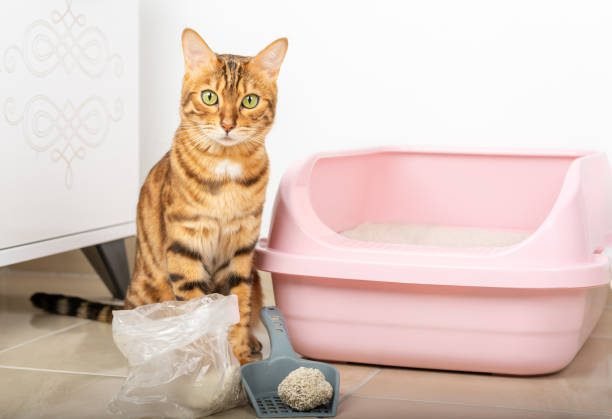
Toilet training your Bengal cat can be a game-changer in maintaining a clean and odor-free home. Here’s a step-by-step guide to make the process smooth:
- Choose the Right Litter Box: Select a suitable litter box that is large enough for your Bengal cat to comfortably use. Some cats prefer covered boxes for privacy.
- Select the Right Litter: Bengals may have preferences for certain types of litter. Experiment with different textures and scents to find the one your cat prefers.
- Place the Litter Box Strategically: Put the litter box in a quiet, easily accessible location. Ensure it is away from their food and water bowls for hygiene reasons.
- Introduce Your Cat Gradually: If your Bengal is used to a traditional litter box, introduce the new setup gradually. Place the new litter box next to the old one, allowing your cat to get accustomed to the change.
- Positive Reinforcement: Reward your Bengal cat with treats or affection when they use the litter box correctly. Positive reinforcement helps create a positive association with the new setup.
- Be Patient: Like any training, toilet training takes time. Be patient, and don’t scold your cat for accidents. Instead, clean any accidents thoroughly to eliminate residual odors.
>>> Unveiling the Enchantment: The Ragdoll Cat Breed
Common Misconceptions Dispelled: Choosing a Bengal as Your Companion
High Maintenance Myth:
Contrary to the belief that all exotic cats require extensive grooming, Bengal cats have a short coat that demands minimal grooming. Their sleek fur reduces shedding, making them a manageable choice for those who appreciate low-maintenance pets.
Wild and Unpredictable Behavior:
While Bengal cats exhibit traits reminiscent of their wild ancestors, they are domesticated and can form strong bonds with their human companions. Proper training, socialization, and understanding their unique needs contribute to a harmonious relationship.
Not Suitable for Families:
On the contrary, Bengal cats can be excellent companions for families. Their playful nature aligns well with the energy of children, and their social disposition allows them to adapt well to a family environment.
Exclusively Indoor Cats:
While it’s essential to provide a safe and secure indoor environment, Bengal cats can also benefit from supervised outdoor access. Constructing a catio or creating a secure outdoor space allows them to experience the outdoors safely.
Reserved and Distant:
Bengal cats may be independent, but they also form strong social bonds with their human companions. Moments of affection, such as purring and gentle kneading, demonstrate their capacity for emotional connection.
Conclusion: A Portrait of Elegance and Spirit
In conclusion, Bengal cats are not just pets; they are a symphony of elegance, spirit, and unique characteristics. Their dynamic nature, coupled with their striking appearance, makes them a breed like no other. Understanding and embracing their behavior, interests, and lifestyle enrich the relationship between humans and these enchanting felines.
FAQs About Bengal Cats
Are Bengal Cats good with children?
Yes, Bengal cats can be excellent companions for children. Their high energy levels align well with the enthusiasm of kids.
How much exercise do Bengal cats need?
Bengals are highly active cats and benefit from regular play and mental stimulation. Interactive toys and play sessions help keep them happy and healthy.
Do Bengal cats get along with other pets?
With proper introduction and socialization, Bengal cats can coexist harmoniously with other pets. Early interactions are key to fostering positive relationships.
How often should I groom my Bengal cat?
Bengal cats require minimal grooming due to their short coat. Weekly brushing and regular nail trims are generally sufficient to keep them well-groomed.
What is the lifespan of a Bengal cat?
With proper care, Bengal cats can live between 12 to 16 years, providing years of joy and companionship to their owners.



